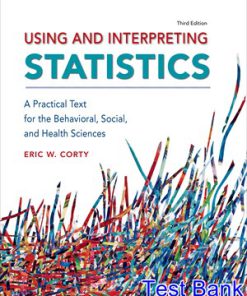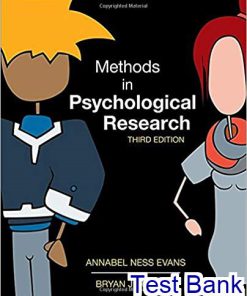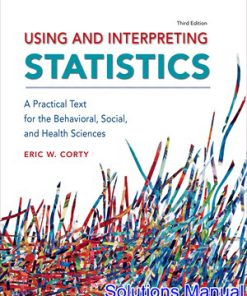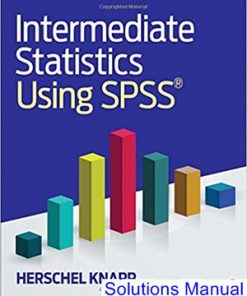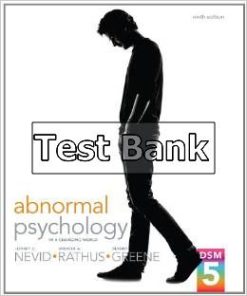Interpreting and Using Statistics in Psychological Research 1st Edition Christopher Test Bank
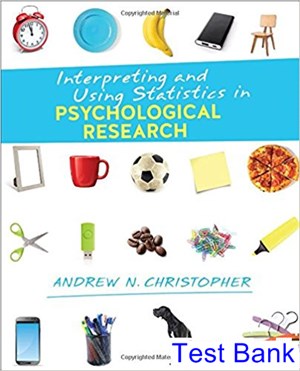
Product details:
ISBN-10:1506304168
ISBN-13:9781506304168
Author: Andrew (Drew) N. Christopher
This practical, conceptual introduction to statistical analysis by award-winning teacher Andrew N. Christopher uses published research with inherently interesting social sciences content to help students make clear connections between statistics and real life. Using a friendly, easy-to-understand presentation, Christopher walks students through the hand calculations of key statistical tools and provides step-by-step instructions on how to run the appropriate analyses for each type of statistic in SPSS and how to interpret the output. With the premise that a conceptual grasp of statistical techniques is critical for students to truly understand why they are doing what they are doing, the author avoids overly formulaic jargon and instead focuses on when and how to use statistical techniques appropriately.
Table contents:
Chapter 1- Why Do I Have to Learn Statistics? The Value of Statistical Thinking in Life
Statistical Thinking and Everyday Life
Failing to Use Information About Probability
Availability heuristic
Representativeness heuristic
Misunderstanding Connections Between Events
Illusory correlations
Gambler’s fallacy
Goals of Research
Goal: To Describe
Goal: To Predict
Goal: To Explain
Goal: To Apply
Statistical Thinking: Some Basic Concepts
Parameters Versus Statistics
Descriptive Statistics Versus Inferential Statistics
Sampling Error
Chapter Application Questions
Questions for Class Discussion
Chapter 2- Basics of Quantitative Research: Variables, Scales of Measurement, and an Introduction to the Statistical Package for the Social Sciences (SPSS)
The Study
Variables
Operational Definitions
Measurement Reliability and Validity
Scales of Measurement: How We Measure Variables
Nominal Data
Ordinal Data
Interval and Ratio (Scale) Data
Discrete Versus Continuous Variables
The Basics of SPSS
Variable View
Data View
Chapter Application Questions
Questions for Class Discussion
Chapter 3- Describing Data With Frequency Distributions and Visual Displays
The Study
Frequency Distributions
Frequency Distribution Tables
Frequency Distribution Graphs
Common Visual Displays of Data in Research
Bar Graphs
Scatterplots
Line Graphs
Using SPSS to Make Visual Displays of Data
Making a Bar Graph
Making a Scatterplot
Making a Line Graph
Chapter Application Questions
Questions for Class Discussion
Chapter 4- Making Sense of Data: Measures of Central Tendency and Variability
Measures of Central Tendency
Three Measures of Central Tendency
Mean
Median
Mode
Reporting the measures of central tendency in research
Choosing a Measure of Central Tendency
Consideration 1: Outliers in the data
Consideration 2: Skewed data distributions
Consideration 3: A variable’s scale of measurement
Consideration 4: Open-ended response ranges
Measures of Central Tendency and SPSS
Measures of Variability
What Is Variability? Why Should We Care About Variability?
Three Measures of Variability
Range
Variance
Standard deviation
Reporting variability in research
Measures of Variability and SPSS
Chapter Application Questions
Questions for Class Discussion
Chapter 5- Determining “High” and “Low” Scores: The Normal Curve, z Scores, and Probability
Types of Distributions
Normal Distributions
Skewed Distributions
Standardized Scores (z Scores)
z Scores, the Normal Distribution, and Percentile Ranks
Locating Scores Under the Normal Distribution
Percentile Ranks
z Scores and SPSS
Chapter Application Questions
Questions for Class Discussion
Chapter 6- Drawing Conclusions From Data: Descriptive Statistics, Inferential Statistics, and Hypothesis Testing
Basics of Null Hypothesis Testing
Null Hypotheses and Research Hypotheses
Alpha Level and the Region of Null Hypothesis Rejection
Gathering Data and Testing the Null Hypothesis
Making a Decision About the Null Hypothesis
Type I Errors, Type II Errors, and Uncertainty in Hypothesis Testing
The z Test
A Real-World Example of the z Test
Ingredients for the z Test
Using the z Test for a Directional (One-Tailed) Hypothesis
Using the z Test for a Nondirectional (Two-Tailed) Hypothesis
One-Sample t Test
A Real-Word Example of the One-Sample t Test
Ingredients for the One-Sample t Test
Using the One-Sample t Test for a Directional (One-Tailed) Hypothesis
Using the One-Sample t Test for a Nondirectional (Two-Tailed) Hypothesis
One-Sample t Test and SPSS
Statistical Power and Hypothesis Testing
Chapter Application Questions
Questions for Class Discussion
Chapter 7- Comparing Two Group Means: The Independent Samples t Test
Conceptual Understanding of the Statistical Tool
The Study
The Tool
Ingredients
Hypothesis from Kasser and Sheldon (2000)
Interpreting the Tool
Assumptions of the tool
Testing the null hypothesis
Extending our null hypothesis test
Using Your New Statistical Tool
Hand-Calculating the Independent Samples t Test
Step 1: State hypotheses
Step 2: Calculate the mean for each of the two groups
Step 3: Calculate the standard error of the difference between the means
Step 4: Calculate the t test statistic
Step 5: Determine degrees of freedom (dfs)
Step 6: Locate the critical value
Step 7: Make a decision about the null hypothesis
Step 8: Calculate an effect size
Step 9: Determine the confidence interval
Independent Samples t Test and SPSS
Establishing your spreadsheet
Running your analyses
What am I looking at? Interpreting your SPSS output
Chapter Application Questions
Questions for Class Discussion
Chapter 8- Comparing Two Repeated Group Means: The Paired Samples t Test
Conceptual Understanding of the Tool
The Study
The Tool
Ingredients
Hypothesis from Stirling et al. (2014)
Interpreting the Tool
Testing the null hypothesis
Extending our null hypothesis test
Assumptions of the tool
Using Your New Statistical Tool
Hand-Calculating the Paired Samples t Test
Step 1: State hypotheses
Step 2: Calculate the mean difference score
Step 3: Calculate the standard error of the difference scores
Step 4: Calculate the t test statistic
Step 5: Determine degrees of freedom (dfs)
Step 6: Locate the critical value
Step 7: Make a decision about the null hypothesis
Step 8: Calculate an effect size
Step 9: Determine the confidence interval
Paired Samples t Test and SPSS
Establishing your spreadsheet
Running your analyses
What am I looking at? Interpreting your SPSS output
Chapter Application Questions
Questions for Class Discussion
Chapter 9- Comparing Three or More Group Means: The One-Way, Between-Subjects Analysis of Variance (ANOVA)
Conceptual Understanding of the Tool
The Study
The Tool
Ingredients
Assumptions of the tool
Hypothesis from Eskine (2012)
Interpreting the Tool
Testing the null hypothesis
Extending our null hypothesis test
Going beyond the F ratio: Post hoc tests
Using Your New Statistical Tool
Hand-Calculating the One-Way, Between-Subjects ANOVA
Step 1: State hypotheses
Step 2: Calculate the mean for each group
Step 3: Calculate the sums of squares (SSs)
Total Sums of Squares (SStotal)
Within-Groups Sums of Squares (SSwithin-groups)
Between-Groups Sums of Squares (SSbetween-groups)
Step 4: Determine degrees of freedom (dfs)
Total Degrees of Freedom (dftotal)
Within-Groups Degrees of Freedom (dfwithin-groups)
Between-Groups Degrees of Freedom (dfbetween-groups)
Step 5: Calculate the mean squares (MSs)
Step 6: Calculate your F ratio test statistic
Step 7: Locate the critical value
Step 8: Make a decision about the null hypothesis
Step 9: Calculate an effect size
Step 10: Perform post hoc tests
One-Way Between-Subjects ANOVA and SPSS
Establishing your spreadsheet
Running your analysis
What am I looking at? Interpreting your SPSS output
Chapter Application Questions
Questions for Class Discussion
Chapter 10- Comparing Three or More Repeated Group Means: The One-Way, Repeated-Measures Analysis of Variance (ANOVA)
Conceptual Understanding of the Tool
The Study
The Tool
Between-subjects versus repeated-measures ANOVAs
Assumptions of the tool
Hypothesis from Bernard et al. (2014)
Interpreting the Tool
Testing the null hypothesis
Extending our null hypothesis test
Going beyond the F ratio: Post hoc tests
Using Your New Statistical Tool
Hand-Calculating the One-Way, Repeated-Measures ANOVA
Step 1: State the hypothesis
Step 2: Calculate the mean for each group
Step 3: Calculate the sums of squares (SSs)
Total Sums of Squares (SStotal)
Between Sums of Squares (SSbetween)
Error Sums of Squares (SSerror)
Step 4: Determine degrees of freedom (dfs)
Total Degrees of Freedom (dftotal)
Between Degrees of Freedom (dfbetween)
Error Degrees of Freedom (dferror)
Step 5: Calculate the mean squares (MSs)
Step 6: Calculate your F ratio test statistic
Step 7: Locate the critical value
Step 8: Make a decision about the null hypothesis
Step 9: Calculate an effect size
Step 10: Perform post hoc tests
One-Way, Repeated-Measures ANOVA and SPSS
Establishing your spreadsheet
Running your analysis
What am I looking at? Interpreting your SPSS output
Chapter Application Questions
Questions for Class Discussion
Chapter 11- Analyzing Two or More Influences on Behavior: Factorial Designs for Two Between-Subjects Factors
Conceptual Understanding of the Tool
The Study
The Tool
Factorial notation
Main effects and interactions
Hypothesis from Troisi and Gabriel (2011)
Interpreting the Tool
Testing the null hypothesis
Extending the null hypothesis tests
Dissecting a statistically significant interaction
Using Your New Statistical Tool
Hand-Calculating the Two-Way, Between-Subjects ANOVA
Step 1: State the hypotheses
Step 2: Calculate the mean for each group and the marginal means
Step 3: Calculate the sums of squares (SSs)
Total Sums of Squares (SStotal)
Within-Groups Sums of Squares (SSwithin-groups)
Between-Groups Sums of Squares (SSbetween-groups)
Step 4: Determine degrees of freedom (dfs)
Total Degrees of Freedom (dftotal)
Within-Groups Degrees of Freedom (dfwithin-groups)
Between-Groups Degrees of Freedom (dfbetween-groups)
Step 5: Calculate the mean squares (MSs)
Step 6: Calculate your F ratio test statistics
Step 7: Locate the critical values
Step 8: Make a decision about each null hypothesis
Step 9: Calculate the effect sizes
Step 10: Perform follow-up tests
Two-Way, Between-Subjects ANOVA and SPSS
Establishing your spreadsheet
Running your analysis
What am I looking at? Interpreting your SPSS output
Dissecting interactions in SPSS
Chapter Application Questions
Questions for Class Discussion
Chapter 12- Determining Patterns in Data: Correlations
Conceptual Understanding of the Tool
The Study
The Tool
Types (directions) of correlations
Strength of correlations
Assumptions of the Pearson correlation
Uses for correlations
Use 1: Studying naturally occurring relationships
Use 2: Basis for predictions
Use 3: Establishing measurement reliability and validity
Hypotheses from Clayton et al. (2013)
Interpreting the Tool
Testing the null hypothesis
Cautions in interpreting correlations
Caution 1: Don’t confuse type (direction) and strength of a correlation
Caution 2: Range restriction
Caution 3: “Person-who” thinking
Caution 4: Curvilinear relationships
Caution 5: Spurious correlations
Using Your New Statistical Tool
Hand-Calculating the Person Correlation Coefficient (r)
Step 1: State hypotheses
Step 2: For both variables, find each participant’s deviation score and then multiply them together
Step 3: Sum the products in step 2
Step 4: Calculate the sums of squares for both variables
Step 5: Multiply the two sums of squares and then take the square root
Step 6: Calculate the correlation coefficient (r) test statistic
Step 7: Locate the critical value
Step 8: Make a decision about the null hypothesis
The Pearson Correlation (r) and SPSS
Establishing your spreadsheet
Running your analysis
What am I looking at? Interpreting your SPSS output
Chapter Application Questions
Questions for Class Discussion
Chapter 13- Predicting the Future: Univariate and Multiple Regression
Univariate Regression
Ingredients
Hand-Calculating a Univariate Regression
Step 1: Calculate the slope of the line (b)
Step 2: Calculate the y-intercept (a)
Step 3: Make predictions
Univariate Regression and SPSS
Running your analysis
What am I looking at? Interpreting your SPSS output
Multiple Regression
Understanding Multiple Regression in Research
Multiple Regression and SPSS
Establishing your spreadsheet
Running your analysis
What am I looking at? Interpreting your SPSS output
Chapter Application Questions
Questions for Class Discussion
Chapter 14- When We Have Exceptions to the Rules: Nonparametric Tests
Chi-Square (x2) Tests
Chi-Square (x2) Goodness-of-Fit Test
Hand-calculating the 2*2 goodness-of-fit test
Step 1: State hypotheses
Step 2: Determine degrees of freedom (dfs)
Step 3: Calculate the x2 test statistic
Step 4: Find the critical value and make a decision about the null hypothesis
x2 goodness-of-fit test and SPSS
Establishing your spreadsheet
Running your analysis
What am I looking at? Interpreting your SPSS output
Chi-Square (x2) Test of Independence
Hand-calculating the x2 test of independence
Step 1: State hypotheses
Step 2: Determine degrees of freedom (dfs)
Step 3: Calculate expected frequencies
Step 4: Calculate the x2 test statistic
Step 5: Find the critical value and make a decision about the null hypothesis
Step 6: Calculate an effect size
x2 test for independence and SPSS
Establishing your spreadsheet
Running your analysis
What am I looking at? Interpreting your SPSS output
Spearman Rank-Order Correlation Coefficient
Hand-Calculating the Spearman Rank-Order Correlation
Step 1: State the hypothesis
Step 2: Calculate the difference (D) score between each pair of rankings
Step 3: Square and sum the difference scores in step 2
Step 4: Calculate the Spearman correlation coefficient (rs) test statistic
Step 5: Locate the critical value and make a decision about the null hypothesis
Spearman’s Rank-Order Correlation and SPSS
Establishing your spreadsheet
Running your analysis
What am I looking at? Interpreting your SPSS output
Mann-Whitney U Test
Hand-Calculating the Mann-Whitney U Test
Step 1: State hypotheses
Step 2: Calculate the ranks for categories being compared
Step 3: Sum the ranks for each category
Step 4: Find the U for each group
Step 5: Locate the critical value and make a decision about the null hypothesis
Mann-Whitney U Test and SPSS
Establishing your spreadsheet
Running your analysis
What am I looking at? Interpreting your SPSS output
Chapter Application Questions
Questions for Class Discussion
Chapter 15- Bringing It All Together: Using Your Statistical Toolkit
Deciding on the Appropriate Tool: Six Examples
Study 1: “Waiting for Merlot: Anticipatory Consumption of Experiential and Material Purchases
Study 2: “Evaluations of Sexy Women in Low- and High-Status Jobs”
Study 3: “Evil Genius? How Dishonesty Can Lead to Greater Creativity”
Study 4: “Differential Effects of a Body Image Exposure Session on Smoking Urge Between Physically Active and Sedentary Female Smokers”
Study 5: “Texting While Stressed: Implications for Students’ Burnout, Sleep, and Well-Being”
Study 6: “How Handedness Direction and Consistency Relate to Declarative Memory Task Performance”
Using Your Toolkit to Identify Appropriate Statistical Tools
Study 7: “Borderline Personality Disorder: Attitudinal Change Following Training”
Study 8: “Effects of Gender and Type of Praise on Task Performance Among Undergraduates”
Study 9: “Please Respond ASAP: Workplace Telepressure and Employee Recovery”
Answers to Studies 7, 8, and 9
Appendices: Statistical Tables
Glossary
References
Index
People also search:
interpreting and using statistics in psychological research 1st
interpreting and using statistics in psychological research 1st edition
interpreting and using statistics in psychological research 1st pdf
interpreting and using statistics in psychological research 1st pdf free
interpreting and using statistics in psychological research 1st download scribd
Instant download after Payment is complete


